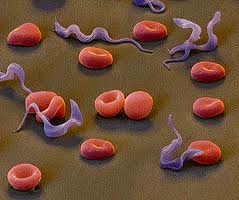Evaluation of antitrypanosomal activity of Adansonia digitata (methanol seed extract) in Albino mice
Keywords:
Trypanosomiasis, Anti-trypansomal, Intraperitoneally, ParasitaemiaAbstract
Adansonia digitata, a shrub used in traditional medicine for the treatment of cancer was investigated for the treatment of experimental trypanosomiasis. Methanol seed extracts of the seed of Adansonia digitata was investigated for in-vivo anti-trypanosomal activity in albino mice infected with Trypanosoma brucei brucei and treated intraperitoneally with the extracts 24 hours post infection, at doses ranging from 50-500mg/kg for 14 days. The parasitaemia in each mouse was monitored including the control group which were treated with the standard drug; berenil. Seed extracts at dose of 400mg/kg showed significant antitrypanosomal activity (P<0.05). Although parasites were not completely cleared from circulation, 67% of the experimental animals survived for over 43 days. The treated control (berenil at dose of 3.5mg/kg) showed 100% survival and parasites were completely cleared. The L.D50 value of the crude seed extract was estimated to be more than 2900mg/kg. Phytochemical screening of the crude extract of the seed indicated the presence of carbohydrate, glycosides, cardiac glycosides, saponins, steroids and triterpene, flavonoids and alkaloids. The result of this study shows that Adansonia digitata has great potential as anti trypanosomal agent, which could be developed into an alternative drug to complement treatment options for African trypanosomiasis.
References
Abdel-Sattar, E., Harraz, F.M., Al-Ansari., S.M.A., El-Mekkawy, S., Ichino, C., Kiyohara, H., Otoguro, K., Omura, S.,
Yamada, H., 2009. Antiplasmodial and antitrypanosomal activity of plants from the Kingdom of Saudi
Arabia. Journal of National Medicine (2009) 63,232–239.
Anosa, V.C., 1988. Haematological and Biochemical changes in human and animal trypanosomiasis. Protozoologie,
(1), 65-78.
Asres, K., Bucar, F., Knauder, E., Yardley, V., Kendrick, H., Croft, S.L., 2001. In vitro antiprotozoal activity of extract
and compounds from the stem bark of Combretum molle. : Research 15(7), 613-617.
Atawodi, S.E., Bulus, T., Ibrahim, S., Ameh, D.A., Nok, A.J., Mamman, M., Galadima, M., 2003. In vitro
trypanocidal effect of methanolic extract of some Nigerian Savannah plants. African Journal of Biotechnol.
(9), 317-321.
Atawodi, S.E., Bulus, T., Ibrahim, S., Amed, D.A., Nok. A.J., Mamman, M., Galadima, M., 2005. In vitro trypanocidal
effect of methanolic extract of some Nigerian savannah plants. African Journal of Biotechnology, 2, 317-321.
Barrett, M.P., Boykin, D.W., Brun, R., Tidwell, R.R., 2007. Human African trypanosomiasis: Pharmacological reengagement with a neglected disease. British journal of pharmacology. 152, 1155-1171.
Berrang-ford, L., Laudine, J., Breau, S., 2011. Conflick and human trypanosomiasis. Social science and medicine. 72,
-407.
Brun, R., Blum, J., Chappuis, F., Burric, C., 2010. Human African the lancet. 375,148-159.
Cecchi, G., Paone, M., Franco, J.R., 2009. Toward atlas of human African trypanosomiasis. Internal journal of
Health Geography. 8, 1-5.
Fevre, E.M., Wissmann, B.V., Welburn, S.G., Lutumba, P., 2008. The burden of human African trypanosomiasis. Plos
neglected tropical disease.2 (12 article e333).
Freiburghaus, F., Kaminsky, R., Nkuna, M.H.N., Brun, R., 1996. Evaluation of African Medicinals for their in vitro
trypanocidal activity. Journal of Ethnopharmacol. 55, 11-21.
Gooding, R.H., 1992. Genetic variation in Tsetse flies and implication for trypanosomiasis. Parasitology today.8, 92-
Hide, G., 1999. History of sleeping sickness in East Africa. Clinical microbiology reviews 12, 112-125.
Hoet, S., Opperdoes, F.R., Brun, R., Adjakidjé, V., Quetin-Leclercq, J., 2004. In vitro antitrypanosomal activity of
ethnopharmacologically selected Beninese plants. J Ethnopharmacol.91, 37–42.
Krafsur, E.S., 2009. Tsetse flies genetics evolution and roles as vectors. Infection, genetic and evolution. 9,124-141.
Louis, F.J., Kohagne, L.T., Ebo, O.T.V., Simarro, P.P., 2008. Organizing an active screening campaign for for human
African trypanosomiasis due to the Trypanosoma brucei gambiense. Medicine tropicale. 68, 11-16.
Mann A, Gbate M, Nda-Umar A., 2003. Medicinal and Economic Plants of Nupeland. Bida, Niger State, Nigeria:
Jube-Evans Books and Publications; p. 276.
Maikai, V.A., 2011. Antitrypanosomal Activity of Flavonoid Extracted from Ximenia Americana Stem Bark.
International Journal of Biology, 3(1), 115-121.
Merschjohann, K., Sporer, F., Steverding, D., Wink, M., 2001. In vitro Effect of Alkaloids on Bloodstream forms of
Trypanosoma brucei and T. congolense. Planta Medicine. 67, 623–627.
Simarro, P.P., Jannin, J., Cattand, P., 2008. Eliminating Human African trypanosomiasis. Where do we stand and
what comes next? Plos medicine.5 (2 article e55).
Sülsen, V.P., Cazorla, S.I., Frank, F.M., Redko, F.C., Anesini, C.A., Coussio, J.D., Malchiodi, E.L., Martino, V.S.,
Muschietti, L.V., 2007. Trypanocidal and Leishmanicidal Activities of Flavonoids from Argentine Medicinal
Plants. Am J Trop Med Hyg. 77(4), 654–659.
WHO, 2010. African trypanosomiasis (sleeping sickness). Geneva, Switzerland technical report. 295.

Published
How to Cite
Issue
Section
Copyright (c) 2013 Hassan Maina Ibrahim, Emmanuel O Ogbadoyi, Maimuna Umar Bello, I. J. Yemisi

This work is licensed under a Creative Commons Attribution-NonCommercial-NoDerivatives 4.0 International License.



